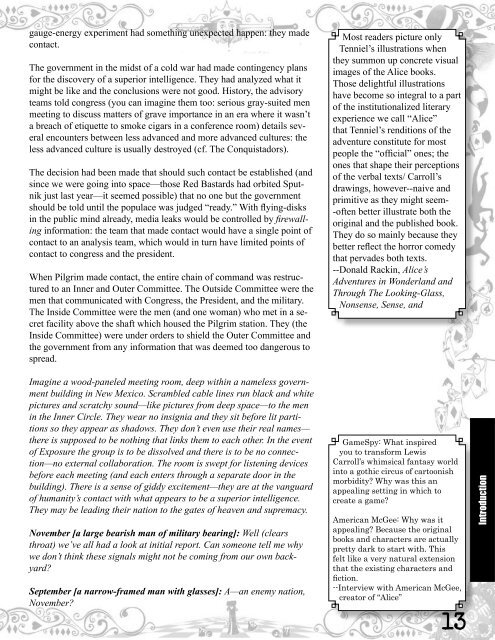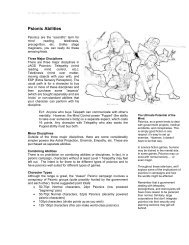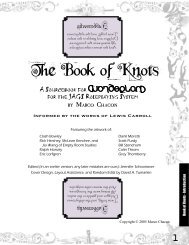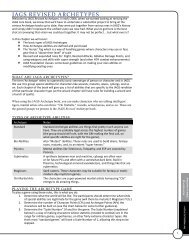Wonderland - Jags
Wonderland - Jags
Wonderland - Jags
Create successful ePaper yourself
Turn your PDF publications into a flip-book with our unique Google optimized e-Paper software.
gauge-energy experiment had something unexpected happen: they made<br />
contact.<br />
The government in the midst of a cold war had made contingency plans<br />
for the discovery of a superior intelligence. They had analyzed what it<br />
might be like and the conclusions were not good. History, the advisory<br />
teams told congress (you can imagine them too: serious gray-suited men<br />
meeting to discuss matters of grave importance in an era where it wasn’t<br />
a breach of etiquette to smoke cigars in a conference room) details several<br />
encounters between less advanced and more advanced cultures: the<br />
less advanced culture is usually destroyed (cf. The Conquistadors).<br />
The decision had been made that should such contact be established (and<br />
since we were going into space—those Red Bastards had orbited Sputnik<br />
just last year—it seemed possible) that no one but the government<br />
should be told until the populace was judged “ready.” With flying-disks<br />
in the public mind already, media leaks would be controlled by firewalling<br />
information: the team that made contact would have a single point of<br />
contact to an analysis team, which would in turn have limited points of<br />
contact to congress and the president.<br />
When Pilgrim made contact, the entire chain of command was restructured<br />
to an Inner and Outer Committee. The Outside Committee were the<br />
men that communicated with Congress, the President, and the military.<br />
The Inside Committee were the men (and one woman) who met in a secret<br />
facility above the shaft which housed the Pilgrim station. They (the<br />
Inside Committee) were under orders to shield the Outer Committee and<br />
the government from any information that was deemed too dangerous to<br />
spread.<br />
Imagine a wood-paneled meeting room, deep within a nameless government<br />
building in New Mexico. Scrambled cable lines run black and white<br />
pictures and scratchy sound—like pictures from deep space—to the men<br />
in the Inner Circle. They wear no insignia and they sit before lit partitions<br />
so they appear as shadows. They don’t even use their real names—<br />
there is supposed to be nothing that links them to each other. In the event<br />
of Exposure the group is to be dissolved and there is to be no connection—no<br />
external collaboration. The room is swept for listening devices<br />
before each meeting (and each enters through a separate door in the<br />
building). There is a sense of giddy excitement—they are at the vanguard<br />
of humanity’s contact with what appears to be a superior intelligence.<br />
They may be leading their nation to the gates of heaven and supremacy.<br />
November [a large bearish man of military bearing]: Well (clears<br />
throat) we’ve all had a look at initial report. Can someone tell me why<br />
we don’t think these signals might not be coming from our own backyard?<br />
September [a narrow-framed man with glasses]: A—an enemy nation,<br />
November?<br />
Most readers picture only<br />
Tenniel’s illustrations when<br />
they summon up concrete visual<br />
images of the Alice books.<br />
Those delightful illustrations<br />
have become so integral to a part<br />
of the institutionalized literary<br />
experience we call “Alice”<br />
that Tenniel’s renditions of the<br />
adventure constitute for most<br />
people the “official” ones; the<br />
ones that shape their perceptions<br />
of the verbal texts/ Carroll’s<br />
drawings, however--naive and<br />
primitive as they might seem-<br />
-often better illustrate both the<br />
original and the published book.<br />
They do so mainly because they<br />
better reflect the horror comedy<br />
that pervades both texts.<br />
--Donald Rackin, Alice’s<br />
Adventures in <strong>Wonderland</strong> and<br />
Through The Looking-Glass,<br />
Nonsense, Sense, and<br />
GameSpy: What inspired<br />
you to transform Lewis<br />
Carroll’s whimsical fantasy world<br />
into a gothic circus of cartoonish<br />
morbidity? Why was this an<br />
appealing setting in which to<br />
create a game?<br />
American McGee: Why was it<br />
appealing? Because the original<br />
books and characters are actually<br />
pretty dark to start with. This<br />
felt like a very natural extension<br />
that the existing characters and<br />
fiction.<br />
--Interview with American McGee,<br />
creator of “Alice”<br />
13<br />
Introduction





